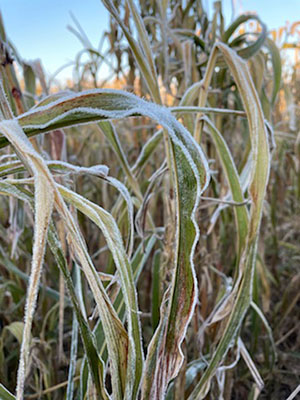Chilly Mornings, Chilly Concerns: Managing Frost-Induced Prussic Acid Risks
10/11/24
AMES, Iowa – Frost is one of the primary environmental factors that can lead to increased prussic acid content in sorghum species, forage sorghum, sorghum x sudangrass, and sudangrass. When a frost occurs, the stress it places on the plant can cause an accumulation of dhurrin, a compound that breaks down into prussic acid. If livestock consume forage with elevated levels of prussic acid, it can result in acute toxicity, leading to symptoms such as muscle twitching, staggering, and even death within minutes.
Iowa State University extension forage specialist Shelby Gruss offered these guidelines for managing risk from frost events.
To mitigate the risk of prussic acid toxicity following a frost, it’s important to take immediate action:
- Remove cattle before the frost. When a frost is forecasted, cattle should be removed from sorghum fields to prevent consumption of potentially toxic forage.
- Wait one week after frost. Cattle should not graze the field for at least one week following a frost. If another frost occurs within the week, the waiting period should extend an additional seven days, effectively restarting the clock.
- Look for regrowth. Following a non-killing frost, scanning the field for regrowth is invaluable because new tillers can have high levels of dhurrin. If the field has a considerable amount of regrowth waiting until the new growth is over 18 in. tall, or is killed by a killing frost is important to avoid high levels of prussic acid.
- Safe grazing sfter a killing frost. After a killing frost, prussic acid levels diminish to safer levels. One week after the killing frost, the forage is generally safe for livestock to graze. Additionally, densely planted sorghum species can help protect the interior from a killing frost. Walking into the field can help determine if the plants were killed.
Feeding alternatives
For producers concerned about managing sorghum forage after a frost, other methods such as silage and baleage offer safer options. The chopping and fermentation process involved in creating silage can reduce prussic acid content by over 50%, making it a safer choice than grazing or hay. Grazing is particularly risky as animals will selectively graze the leaf material which will accumulate higher levels of dhurrin. Haying at this point in time would be VERY difficult to dry down. Additionally, haying, contradictory to previously thought, does not reduce your risk of prussic acid potential.
Testing for prussic acid
If there is any doubt about the safety of sorghum forage following a frost, it is recommended to send samples for lab analysis. Fresh forage samples should be sealed in a high-quality plastic bag and chilled before being sent to a laboratory for testing.
For prussic acid testing, send samples to:
Veterinary Diagnostic Laboratory
Iowa State University
1850 Christensen Drive
Ames, IA 50011
By following these guidelines, sorghum species can continue to be a safe and valuable forage resource for livestock. Proper management after frost events is critical to avoiding prussic acid toxicity and ensuring livestock safety.
-30-
The Iowa Beef Center at Iowa State University was established in 1996 with the goal of supporting the growth and vitality of the state’s beef cattle industry. It comprises faculty and staff from Iowa State University Extension and Outreach, College of Agriculture and Life Sciences and College of Veterinary Medicine, and works to develop and deliver the latest research-based information regarding the beef cattle industry. For more information about IBC, visit www.iowabeefcenter.org.
Contact:
Shelby Gruss, ISU extension forage specialist, 515-294-3832, sgruss@iastate.edu


